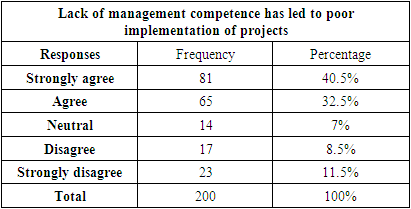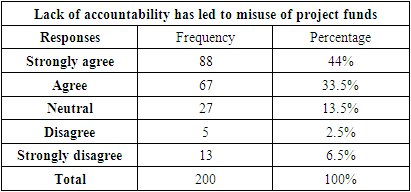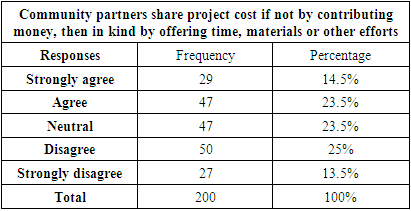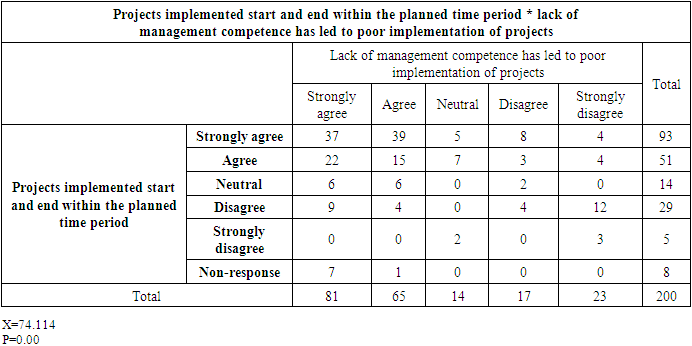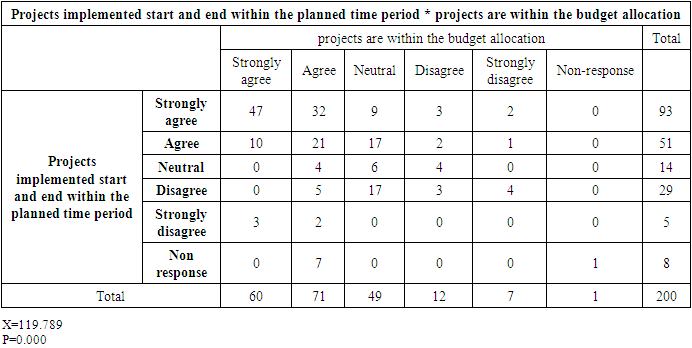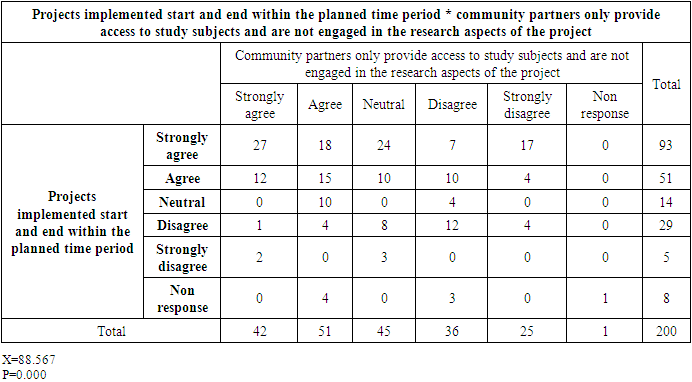-
Paper Information
- Paper Submission
-
Journal Information
- About This Journal
- Editorial Board
- Current Issue
- Archive
- Author Guidelines
- Contact Us
Journal of Experience Research
2024; 1(1): 1-10
doi:10.5923/j.jer.20240101.01
Received: Feb. 10, 2024; Accepted: Mar. 6, 2024; Published: Mar. 20, 2024

Factors Affecting the Success of Project Implementation: The Case of One Non-Governmental Organisation in Zambia
Elizabeth Kaputa 1, Tembo Simon 2
1Graduate School of Business, University of Zambia, Lusaka
2Department of Electrical and Electronics Engineering University of Zambia, Lusaka
Correspondence to: Elizabeth Kaputa , Graduate School of Business, University of Zambia, Lusaka.
| Email: |  |
Copyright © 2024 The Author(s). Published by Scientific & Academic Publishing.
This work is licensed under the Creative Commons Attribution International License (CC BY).
http://creativecommons.org/licenses/by/4.0/

The main objective of the study was to determine the critical factors affecting the success of project implementation in the case of one NGO in Zambia. The study also had three (3) specific objectives and 3 research questions which were answered in this study. The first research question was to find out what the influence of management competence on the implementation of projects in NGOs in Zambia was. It was found that lack of Management competence led to poor implementation of projects and came about because management needed specific training on how to manage the projects. The second research question was to find out what the effects of funds accountability on the implementation of projects in NGOs in Zambia were. It was found that funds accountability was another important aspect that led to failure of project implementation because it led to misappropriation of funds and hence leading to failure of completion of projects. The third and last research question was to find out whether community participation had an influence on the implementation of projects in NGOs in Zambia. It was found that community participation was also needed but it was discovered that there was no significant difference between those who said that the community participated through the contribution of money to support the projects and those who said that they did not participate. Thus, community participation in projects was less. The study thus came up with three recommendations based on the findings and these included (1) Projects should set out the requirements from the community so that managers and project supervisors would know what could be required of the community, (2) Project Managers should be trained to be competent in project management so that project implementation would be effective almost all the time and (3) Budgeting before embarking on a project was considered to be very important although there it was not done in some instances which led to lack of proper accountability. Project managers and project supervisors including anyone participating in the project should be involved in budgeting.
Keywords: Project implementation, Factors, NGOs
Cite this paper: Elizabeth Kaputa , Tembo Simon , Factors Affecting the Success of Project Implementation: The Case of One Non-Governmental Organisation in Zambia, Journal of Experience Research, Vol. 1 No. 1, 2024, pp. 1-10. doi: 10.5923/j.jer.20240101.01.
Article Outline
1. Introduction
- The implementation of most projects in developing countries is amalgamated with normal operational undertaking in functional organizations that have low project management Capacity (Anderson, 2018). Implementation of projects in the public sector has been observed to be plagued with a wide range of problems and issues. Chua (2009) asserted that project success is not dictated solely by the monitoring and control efforts and the project manager. Notably, most projects still do not achieve the expected goals. Hence, this has led to cost overruns and project delays. Over the world, there have been more occurrences of project failures than project success.The Project management methods have been extensively used by many public and private entities to solve their problems, manage scarce resources and achieve important objectives (Andersen, 2008). However, Anderson (2008) noted that the implementation part of the project is the pillar to success or failure of the project. Adzawodah (2009) notes that project failure is described on two levels: being failure to implement the project effectively and the inability of the project facilities created to achieve the intended impact. These situations have been associated with weak institutional and financial arrangements.
1.1. Problem Statement
- Over the years, NGOs in Zambia have adopted several measures aimed at addressing the socio-economic conditions of the people to redressing the imbalances between rural and urban areas in terms of development. Many NGOs in this regard have and continue to implement varied initiatives in Agriculture, Health, Education, Science, Technological Research and more importantly, Women Development advocacies. Unfortunately, many NGOs in Zambia continue to face several challenges such lack of funding, limited resources, bureaucratic obstacles, political instability, cultural barriers, and difficulty in measuring impact and effectiveness which affect their project implementation. Additionally, NGOs may also face challenges related to community engagement, sustainability, and capacity building. The Zambian government have not been able to assess and help identify discrepancies between design considerations and actual ground conditions in certain areas whereas financial management, project supervision and community representativeness has been low. The foregoing has resulted into inevitable cost overruns, time overrun, idling resources, and inconveniences to the targeted beneficiaries of projects implemented by NGOs. Despite the challenges being face by NGOs in project implementation, there are no recent studies that have conducted to determine influence of these challenges on project implementation. This necessitated this research to understand the reasons/factors which affect project implementation among NGOs as understanding this would help stakeholders to direct their scare resources to the factors leading to project success.
2. Literature Review
- Mapetere et al., (2012) study on strategic role of leadership in strategy implementation in Zimbabwe's state-owned enterprises showed that top management or leadership predominantly used their technical skills to spearhead strategy implementation. The survey revealed that most State-Owned Enterprises’ top leadership failed to craft and articulates a worthwhile vision for chosen strategies and their subsequent implementation processes.Further findings of Mapetere et al., (2012) research established that most strategies failed due to the inability of leaders to make use of their various skills to create the awareness and show the strategy implementation roadmap as most of the strategy implementers were not aware of leadership expectations. They recommend that leadership should make use of their skills and abilities such as Human, technical, and conceptual skills to create the need for change and enhance strategy implementation receptivity through imparting knowledge, motivation and guidance to strategy implementation individuals and teams.Muthama (2016) conducted a study to determine the effects of cash management practices on operational performance of selected public hospitals in Kisii County. The response rate indicated that all the respondents (100%) expressed that the hospitals keep accounting records. Further on the frequency of maintaining accounting records, the study realized that 72.8% of the respondents felt that the records were kept “often”. This could be due to the requirement by the Public Accounting Procedures and the Ministry of Heath that all the public offices handling money must maintain proper accounting records to ensure accountability of the public funds.Kaptui and Omondi (2020) sought to find out the factors affecting projects implementation in state corporations in Kenya. The study found that funds accountability was the most influential variable on projects implementation. The positive aspect in the findings implied that an increase in funds accountability will increase project implementation phase. The findings also revealed that management competence increases projects implementation in the state corporations in Kenya.Okumu (2012) reviewed Projects implemented by CBOs in Kenya and observed that they face numerous challenges among them poor leadership and governance issues especially in accountability and transparency (Kaaka 2013). For instance, the Child Regional Support Services, a CBO that caters for children living in slum areas in Kenya has faced various problems while implementing its projects. These include employees who have not been adequately trained, lack of commitment between major stakeholders as well as poor management of funds. It is evident that, for long time project money has not been managed in a transparent manner and that the communities are not sufficiently involved in its management leading to loss of funds, numerous incomplete, low quality, and irrelevant projects.In Kenya, Community based organizations have been affected by various factors while implementing their projects (Obisi, 2012). CRESS Kenya, a community-based organization that is involved in support programmes to those affected by HIV has not been able to fully achieve its objectives of fully implementing their programmes due to poor leadership as well as poor management of funds (Wafula &Ndirangu, 2019). Several other Community Based Organizations are involved in the implementation of various projects in Kenya. Several issues in their management have made them not to achieve the desired results. This includes mismanagement of these project funds (Wafula & Ndirangu, 2019).A stakeholder can influence the implementation of a project due to his or her strength or force (Moore, 2013). Stakeholders must play a central role in setting up priorities and objectives to ensure relevance and appropriateness. Influence and power of a stakeholder can affect the success or failure of an initiative (Karanja 2010). The number of stakeholders is an indicator of project stakeholders (Kaaka, 2013). Also, the skills of project stakeholders are indicators of project stakeholders (Lopes, 2012). (Mkutu, 2011) states that the level of education among stakeholders is an indicator of project stakeholders. Therefore, the number of project stakeholders, the skills of project stakeholders as well as the level of education of stakeholders are indicators of project stakeholders.
3. Theoretical/Conceptual Framework
- From the empirical studies reviewed the researcher was able to identify the various factors affecting the success of project implementation. Using Figure 3.1, the conceptual framework seeks to explain if the management competence, funds accountability and community participation affect the implementation of Non-Governmental Organizational Projects.
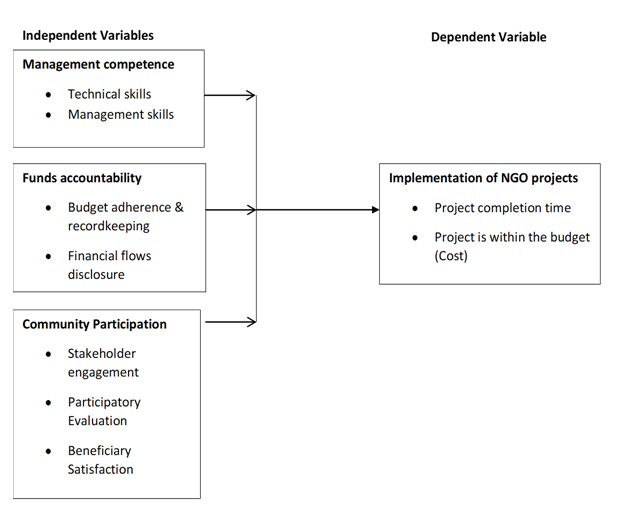 | Figure 3.1. Conceptual framework |
4. Methodology
4.1. Research Approach and Design
- This study adopted a positivist research approach. A positivist approach prefers collecting quantitative data using objective research methods, such as closed questionnaire, structured interviews, and experiments (Kothari, 2004). It claims that the social world can be understood in an objective way. In this research philosophy, the scientist is an objective analyst and, since it, dissociates himself from personal values and works independently. The research used the positivist research philosophy to achieve its objectives and answer the research questions to proceed in the research without being influenced by any bias or personal opinions. Bias is an unfair preference for someone or something. Therefore, opting for this philosophy helped the researcher to reduce bias and subjectivity in the work, which is an outlook guided by their personal judgments and beliefs.A descriptive research design with a survey method was applied in this research in attempting to describe and explain the factors affecting projects implementation in NGOs in Zambia, by using questionnaires to fully describe the phenomenon. The study adopted an explanatory or causal approach using a descriptive survey design.
4.2. Study Area
- The study was conducted on Kabwe Town of Zambia. The selected area involved citizens from urban areas.
4.3. Study Population
- The target population for the study were project managers and employees at one NGO in Kabwe. The sampling frame for the study consisted of staffs in all the projects conducted by the various departments in the NGO. There are a total of 20 projects running in the NGO.
4.4. Participant Selection
- The study population was chosen from among employees at one NGO in Kabwe. The sampling frame for the study consisted of staffs in all the projects conducted by the various departments in the NGO. There was a total of 20 projects running in the NGO. Stratified random sampling was employed in the selection of the research sample to group the various employees into four different strata, which included project managers, supervisors, and technical employees. Sekaran and Bougie (2010), asserted that stratified random sampling involved a process of stratification or segmentation, followed by random selection of subjects from a stratum. Thereafter, a sample of 200 respondents were selected purposively from the four strata (departments).
4.5. Sampling
- Stratified random sampling was employed in the selection of the research sample to group the various employees into different strata, which included project managers, supervisors, and technical employees.
4.6. Data Collection Instruments
- In this study the research questionnaire was used as the main tool for data collection. A questionnaire is a research tool featuring a series of questions used to collect useful information from respondents (Kombo and Tromp, 2006). The research questionnaire was used because it is efficient, cost effective and it allowed the research to collect information in the shortest possible period of time from the respondents.
4.7. Data Collection Procedure
- Data was collected through primary sources by means of individual questionnaires. The structured questionnaire was administered to the respondents (NGO staff) personally to shorten the response time and enable on the spot clarification of any doubt that the respondents might have had regarding any questions. Thereafter, the researcher collected the questionnaires.
4.8. Data Analysis
- The data was analyzed using descriptive statistics, and presented by use of, tables, percentages, and frequencies. The analysis was done with the help of the statistical package for social sciences (SPSS) software. The study also applied cross tabulations analysis using the chi-square test and the p-value to determine whether the perceived relationships in the stated hypotheses were significant.
4.9. IRB and Ethical Considerations
- Before data collection commenced, ethical clearance was sought from the Humanities and Social Sciences, Research Ethics Committee (HSSREC). Thereafter, permission was sought from the NGO to conduct this research from their institutions. The names of the participants were not revealed, and participants were free to withdraw from the study at any time. If a participant did not want to respond to any question, s/he was free to remain mum.In terms of confidentiality, every piece of information collected in this study was treated strictly confidential. Anonymity was observed, all respondents to this research were kept anonymous. The questionnaire did not request for the respondents’ names, contact details, address, except for general variables such as age group, gender and level of education. Informed consent was also observed as the respondents were not coerced to participate. The researcher explained the objective of the study, who had the access to the findings and how the findings would be used.
5. Results and Discussion
5.1. Background Characteristics
5.1.1. Gender
- Figure 5.1 below shows that the percentage distribution of respondents by sex/gender. It showed that more than half 52% (103/200) of the respondents were female while less than half 48% (97/200) of the respondents were male. Gender was considered by the researcher because gender influences human options, conditions, and experiences. A deep understanding of gender patterns, dynamics and biases is key was key in enhancing the accuracy and scope of work in this study.
 | Figure 5.1. Gender |
5.1.2. Level of Education
- According to the findings in the figure 5.2 below, most 70.5% (141/200) of the respondents had university education while the minority 5.5% (11/200) had secondary education. It was also found that about 24% (48/200) of the respondents had college education while no 0% (0/200) respondent was completely uneducated nor primary education. Understanding the demographic characteristic of education level in this research was crucial for several reasons. It helped researcher to identify patterns and trends in data, make informed decisions about the sample and interpret the results of the study accurately. Education level was considered among the demographics because it can also influence individuals' attitudes, behaviors, and beliefs, making it an important variable to consider in research.
 | Figure 5.2. Level of education |
5.2. Influence of Management Competence on Project Implementation
- According to the study findings, it was observed that most employees agreed that lack of management competence in NGOs in Zambia had led to poor implementation of the projects. This meant that the competence of management affected or influenced the way projects were implemented. It was also further observed that when respondents were asked about their opinion concerning whether managers were well trained, most employees said that the managers were well trained although they lacked competence in management.These findings were like the findings of Mapetere et al., (2012) research which established that most strategies failed due to the inability of leaders to make use of their various skills to create the awareness and show the strategy implementation roadmap as most of the strategy implementers were not aware of leadership expectations. The findings in this research also showed that despite management being trained, respondents felt that they were not competent enough to implement projects. Further analysis from the hypotheses on the significant relationship between project implementation and management competence showed that a relationship existed. The findings showed that there was a relationship between project implementation and management competence. It was seen that most employees had agreed to the opinion statement that projects started and ended within the time and agreed that lack of management competence had led to poor implementation of projects. These findings meant that any lack of management competence meant that project management would not be properly implemented to larger extent. The study further established that management competence on project implementation is significant as competent managers can effectively plan, organize, lead, and control project activities to ensure successful outcomes. It was found that when a manager is competent, the organization is more likely to meet project objectives and deliver projects on time and within budget. Influence of management competence on project implementation in NGOs is Zambia is significant. For example, table 5.1 below shows that lack of management competence leading to poor project implementation.
|
5.3. Effects of Funds Accountability on the Implementation of Projects in NGOs in Zambia
- The result from the findings were that more than 70% of the employees agreed to the opinion statement that lack of accountability had led to misuse of project funds among NGOs in Zambia and only 30% of them disagreed. Therefore, accountability was lacking, and it led to misuse of project funds in NGOs. It was further established that lack of accountability in organizations can lead to misuse of funds as there is no oversight or transparency in how money is being spent. This can result in funds being used for personal gain or non-essential expenses rather than for the intended purpose.Further analysis also showed that the projects that some NGOs in Zambia embarked on were within the budget allocations. This was because the majority 65.5% of the employees either agreed or strongly agreed to the opinion statement that projects were within the budget allocation as compared to only a combined 35% of the employees who either disagreed or strongly disagreed to the opinion statement or just remained neutral to the opinion statement.In this study, the relationship between project implementation and financial accountability was tested. It was found that there was a significant relationship between project implementation and financial accountability. Combining the findings in this study showed that there was the relationship that existed, and it was a negative one. This was so because most of the employees said that lack of funds accountability led to misuse of project funds which in turn led to lack of financial accountability. According to the study findings, the accountability of funds in NGOs in Zambia is crucial for the successful implementation of projects. When funds are managed transparently and responsibly, it helps build trust with donors and stakeholders, ensures that resources are used efficiently, and ultimately leads to better project outcomes. This is because accountability in fund management helps NGOs demonstrate to donors and the public that their resources are being used effectively and for the intended purposes. Proper financial accountability allows NGOs to track the progress of their projects, identify any potential issues or challenges, and make informed decisions to address them.Additionally, the study findings established that accountability mechanisms such as financial audits and reporting requirements help NGOs comply with legal and regulatory standards, as well as internal policies and procedures and donors are more likely to support NGOs that can demonstrate accountability and transparency in their financial management practices, leading to more sustainable funding opportunities.Table 5.2 below shows the percentage as well as frequency distribution of respondent’s view on the opinion statement that, ‘lack of accountability has led to misuse of project funds.’ It was found that most 44% (88/200) of the respondents strongly agreed to the statement while the lowest 2.5% (5/200) number of respondents disagreed to the statement. The findings also showed that 33.5%, 13.5% and 6.5% of the respondents agreed, were neutral and strongly disagreed to the opinion statement.
|
5.4. The Influence of Community Participation on the Implementation of Projects in NGOs in Zambia
- The study findings on influence of community participation on implementation of projects in NGOs inn Zambia revealed that community participation in projects was less. This was because most of the employees agreed to the opinion statement that community partners only provided access to study subjects and were not engaged in the research aspects of the project. However, it was further discovered that there was no significant difference in the number between those who disagreed to the opinion statement that opinion statement that, ‘community partners shared project cost if not by contributing money, then in kind by offering time or materials or other efforts.’ and those who agreed. This was because the findings showed that combining responses of disagreeing 38.5% and comparing with the combined responses for agreement 38% to the opinion statement, the difference was only 0.5% or 1 person. This meant that community partners shared the project costs to a certain extent in some instances and in other cases they couldn’t participate. The results could not show the extent to which they could be relied on. Nonetheless, the study results established when community partners share project costs with NGOs by offering time, materials, or other efforts instead of contributing money, it's known as in-kind contributions. In-kind contributions can be valuable for various projects and initiatives.The findings in table 5.3 below showed that most (25%) of the respondents disagreed to the opinion statement that community partners share project cost if not by contributing money, then in kind by offering time, materials, or other efforts while the lowest number of respondents strongly disagreeing. It was also found that 23.5%, 23.5% and 14.5% of the respondents agreed, remained neutral and strongly agreed to the opinion statement. From the table above, there was no significant difference in the number between those who disagreed to the opinion statement and those who agreed.
|
5.5. Hypothesis testing
5.5.1. The First Hypothesis
- Null hypothesisH0 = there was NO significant relationship between project implementation and management competence. Alternative hypothesis H1= there was a significant relationship between project implementation and management competence.Table 5.4 below showed the cross tabulation between the opinion statement about projects being implemented starting and ending within the planned time and the opinion statement about the lack management competence leading to poor implementation of projects. The results in the table showed that the chi-square level was 74.114 and the p-value <0.05. The results meant that the null hypothesis (H0) was rejected because the p value was less than 0.05. That is, the alternative hypothesis that there was a significant relationship between project implementation and management competence was accepted.
|
5.5.2. The Second Hypothesis
- Null hypothesisH0 = there was NO significant relationship between project implementation and funds accountability.Alternative hypothesis H1= there was a significant relationship between project implementation and funds accountability.
|
5.5.3. The Third Hypothesis
- Null hypothesisH0 = there was NO significant relationship between project implementation and community participation.Alternative hypothesis H1= there was a significant relationship between project implementation and community participation.
|
6. Discussion
- In order to determine the factors affecting the success of project implementation, three (3) specific objectives were stated and these included: firstly, determining the influence of management competence on the implementation of projects in NGOs in Zambia, secondly, establishing the effects of funds accountability on the implementation of projects in NGOs in Zambia and thirdly, examining the influence of community participation on the implementation of projects in NGOs in Zambia. These objectives have been analyzed respectively and the results have been presented in the graphs, tables, and pie charts above.Concerning the influence of management competence on the implementation of projects in NGOs in Zambia, it was observed that most employees agreed that lack of management competence had led to poor implementation of the projects. This meant that the competence of management affected or influenced the way projects were implemented. It was also further observed that when respondents were asked about their opinion concerning whether managers were well trained, most employees said that the managers were well trained although they lacked competence in management.These findings were like the findings of Mapetere et al., (2012) research which established that most strategies failed due to the inability of leaders to make use of their various skills to create the awareness and show the strategy implementation roadmap as most of the strategy implementers were not aware of leadership expectations. The findings in this research also showed that despite management being trained, respondents felt that they were not competent enough to implement projects. Further analysis from the hypotheses on the significant relationship between project implementation and management competence showed that a relationship existed. The findings showed that there was a relationship between project implementation and management competence. It was seen that most employees had agreed to the opinion statement that projects started and ended within the time and also agreed that lack of management competence had led to poor implementation of projects. These findings meant that any lack of management competence meant that project management would not be properly implemented to larger extent. The second objective of the study was establishing the effects of funds accountability on the implementation of projects in NGOs in Zambia. The result from the findings were that more than 70% of the employees agreed to the opinion statement that lack of accountability had led to misuse of project funds and only 30% of them disagreed. Therefore, accountability was lacking, and it led to misuse of project funds in NGOs. Further analysis also showed that the projects that organizations embarked on were within the budget allocations. This was because the majority 65.5% of the employees either agreed or strongly agreed to the opinion statement that projects were within the budget allocation as compared to only a combined 35% of the employees who either disagreed or strongly disagreed to the opinion statement or just remained neutral to the opinion statement.In this study, the relationship between project implementation and financial accountability was tested. It was found that there was a significant relationship between project implementation and financial accountability. Combining the findings in this study showed that there was the relationship that existed, and it was a negative one. This was so because most of the employees said that lack of funds accountability led to misuse of project funds which in turn led to lack of financial accountability. The third objective was to examine the influence of community participation on the implementation of projects in NGOs in Zambia. It was found that community participation in projects was less. This was because most of the employees agreed to the opinion statement that community partners only provided access to study subjects and were not engaged in the research aspects of the project. It was further discovered that there was no significant difference in the number between those who disagreed to the opinion statement that opinion statement that, ‘community partners shared project cost if not by contributing money, then in kind by offering time or materials or other efforts.’ and those who agreed. This was because the findings showed that combining responses of disagreeing 38.5% and comparing with the combined responses for agreement 38% to the opinion statement, the difference was only 0.5% or 1 person. This meant that community partners shared the project costs to a certain extent in some instances and in other cases they couldn’t participate. The results could not show the extent to which they could be relied on.
7. Conclusions
- All in all, it can be said that the critical factors affecting the success of project implementation revolved around three (3) specific factors which included (1) management competence on the implementation of projects, (2) funds accountability on the implementation of projects and (3) the influence of community participation on the implementation of projects in NGOs in Zambia. The three factors mentioned affected the way projects were implemented and their success in different ways. Lack of Management competence led to poor implementation of projects and came about since management needed specific training on how to manage the projects. Funds accountability was another important aspect that led to failure of project implementation since it led to misappropriation of funds and hence leading to failure of completion of projects. The community participation was also needed but it was discovered that there was no significant difference between those who said that the community participated through the contribution of money to support the projects and those who said that they did not participate. Thus, community participation in projects was less.
8. Recommendations
- In view of the findings above findings, the following recommendations were made:1. Projects should set out the requirements from the community so that managers and project supervisors would know what could be required of the community. 2. Project Managers should be trained to be competent in project management so that project implementation would be effective almost all the time. 3. Budgeting before embarking on a project was very important although there it was not done in some instances which led to lack of proper accountability. Project managers and project supervisors including anyone participating in the project should be involved in budgeting.
ACKNOWLEDGEMENTS
- I would like to thank my supervisor Dr. Simon Tembo for being a constant source of support from the beginning of the project proposal up to completion of the project. I thank the University of Zambia - Graduate School of Business for equipping me with knowledge, resources, and constant support during the project period. I wish to thank the Kabwe community for their support. I would like to thank family for urging me on in my endeavor to complete this project and being a constant source of support. Sincere thanks go to all lecturers that helped reach this far. My heartfelt appreciation goes to my family for the continuous support and encouragement.
 Abstract
Abstract Reference
Reference Full-Text PDF
Full-Text PDF Full-text HTML
Full-text HTML